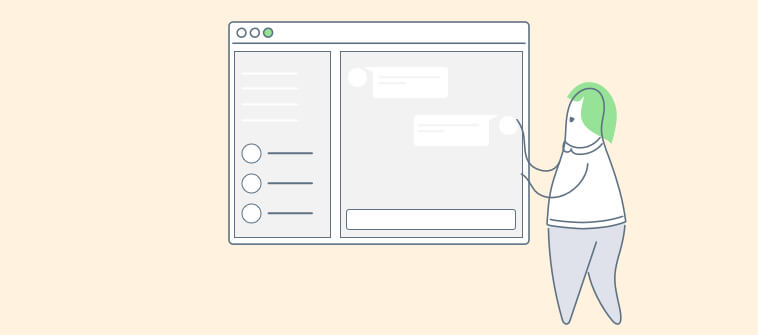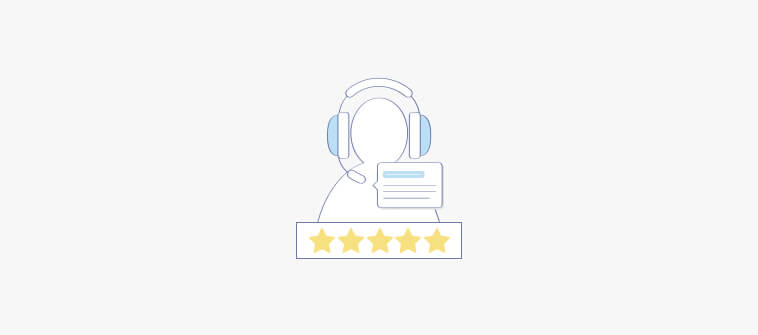Many people think that customer service is an individual sprint. In reality, it’s a relay race.
While most agents can answer a customer question on their own, you need a collaborative effort if you want to identify and fix the problem once and for all.
When you encourage customer service teamwork and collaboration, you can improve the way your team works and resolves customer problems. Internal collaboration can lead to real-time communication, faster problem-solving, and better service quality.
So if you wish to make your customer service heroes work in complete synchronization and amplify customer satisfaction, you have come to the right place.
In this blog, we will discuss the top 8 ways to boost customer service collaboration in your business. Right from the best help desk software for internal collaboration to various team-building exercises, there is a lot that you will find useful.
Let’s go!
What is Customer Service Team Collaboration?
Customer service team collaboration is a process where all team members work together to achieve the desired objectives such as reducing wait times, enhancing customer satisfaction, improving skills, and so on.
Customer service teamwork emphasizes creative thinking, internal communication, and regular feedback. While service reps usually hold one-to-one interactions with customers, they need to work together for delightful service. For example, when customers complain about a faulty product feature, all service reps need to communicate with each other, understand the cause, and figure out the best response to share with customers.
Why Collaboration is Crucial for Exceptional Customer Service
“Customer service shouldn’t just be a department, it should be the entire company.” – Tony Hsieh
When customers say that Brand X has exceptional customer service, they are not referring to a single agent, they are referring to the entire company. After all, in order to delight customers, every employee needs to embrace a customer-centric culture.
Let’s look at some points that highlight the importance of collaboration in business:
- Encourage Problem Solving: Solving complex problems can be taxing when individuals work on their own. However, when customer service teams adopt a collaborative approach, different members can share different perspectives and fix the problem before it becomes detrimental to the customer experience or the business.
- Allow Employees to Learn from Each Other: Your experienced support agents are a storehouse of knowledge. If everyone works on their own, there will be no means to share knowledge and learn. On the other hand, creating the right learning culture can lead to meaningful interactions and improve collaboration between departments.
- Deliver Faster Service: Globally, around 18% of customers expect a brand to respond to their social media questions within one hour. When customer service reps can collaborate in real-time using help desk software, drop comments, share files, chat internally with other departments, etc., they can delight customers with quick responses.
- Reduce Employee Stress: Customer service members are always dealing with angry and complaining customers, adding to their daily work stress. By allowing employees to discuss innovative ideas and share their concerns, you can create an open, friendly atmosphere and reduce employee stress.
How to Excel at Customer Service Team Collaboration
Fostering a collaborative team environment is not a simple feat. You need to take necessary actions and instill cooperative values in your customer service team.
Here are 8 strategies you can adopt today for better customer service teamwork and collaboration:
1. Find the Right Ticketing Solution
Modern customer service teams are dependent on the best help desk software for their day-to-day tasks and activities. Therefore, it becomes all the more important to go for a ticketing solution that facilitates internal collaboration and makes collaborating with customers a breeze.
Fundamentally, the help desk tool you employ should offer the shared inbox feature, which plays a critical role in assigning a specific ticket to a specific agent, or tracking who is working on which issue. This way, team members can pitch in whenever and wherever needed, and their contribution is clearly denoted.
Ticketing solutions also offer a feature called Private Notes/Comments that agents can use to discuss complex issues with each other before responding to the customer.
Ideally, you want each issue to be assigned to the right person on the first go, but agents should have a certain degree of freedom to escalate the issue if they are not qualified to resolve it.
Read More: How to Choose the Best Help Desk Software in Simple Steps
2. Prioritize Team-Based Goals
Apart from making it easier for agents to communicate with one another, you can actively encourage team collaboration through team-oriented KPIs. If your team is forced to work together to achieve the goals you’ve set out, chances are, they’ll begin doing so.
For example, you can focus more on team-based metrics such as your team’s average first response time, average ticket resolution time, overall customer satisfaction, etc.
However, this does not mean that individual performance metrics are not important. As a leader, you still need to hold people accountable for their individual efforts and contributions. The idea is to create the right balance between the KPIs you monitor. With the right help desk software, you can help you monitor both individual and team performance in a single dashboard.
By allowing agents to focus on team-based goals, you’re improving their ability to coordinate, work in sync, and achieve better results – it’s as simple as that.
Read More: 15 Help Desk Metrics to Improve Customer Support
3. Encourage Team Members to Brainstorm
Your customer service department can never improve if you continue to do the same things in the same way. Encourage team members to raise questions about how things are done and share alternative solutions.
Initially, many team members can feel intimidated about sharing their thoughts or ideas. As a manager, you need to step in here and foster an open dialogue. Tell team members that they are free to share their ideas and will not be judged for the same.
So in which cases can you ask your team members to brainstorm?
Well, there can be multiple situations that require a healthy brainstorming session. For example, if your team wants to encourage self-service among customers, you can raise this question on any collaboration tool you use – “How do we get more customers to resolve their issues on their own? Get your creative juices flowing and share relevant ideas.”
You will be surprised to notice that you can generate awesome ideas and get past problems quickly as a team.
4. Focus on Individual Strengths for Better Teamwork
Do you constantly focus on your team members’ weaknesses instead of their strengths? Well, if you want to encourage teamwork for customer service, you need to turn this view upside down.
Spend a good amount of time understanding each member’s unique strengths, skillsets, and abilities. You can refer to past agent ratings, conduct personality tests, or simply ask agents what they feel they are great at.
You will notice that while one service rep knows positive body language skills and can hold great face-to-face interactions with customers, someone else might have a technical bent of mind and be great at resolving technical problems.
Once you have identified individual strengths, it’s all about putting the puzzle pieces in the right place to get a beautiful “bigger picture.” When everyone can work to their strengths, you will come across as a stronger and better support team.
Read More: 16 Tips for Managing a Remote Customer Service Team
5. Conduct Effective Team-Building Exercises
Team-building exercises have a negative reputation as many leaders feel they can lead to time wastage. But when done right, these exercises can encourage team collaboration, enhance employee morale, as well as, productivity.
The purpose of customer service team-building exercises is to encourage collaboration rather than competition.
Here are some team-building exercises you can consider for your support staff:
- The Spaghetti Marshmallow Challenge. Basically, you create teams of 4-5, and each is challenged to get a marshmallow as high as possible off a flat surface (like a table). The catch? You can only use 20 pieces of spaghetti, a yard of string, and a yard of tape. The team with the highest marshmallow at the end of 30 minutes wins!
- Take your team out to lunch in a somewhere nice location, and have a walk around afterward. Or throw a party!
- Laser tag, or paintball if you’re feeling adventurous. This will prove a little more difficult to organize though.
A study by the Kenexa Research Institute found 50% of the positive changes in communication patterns within the workplace can be credited to social interaction outside of the workplace.
While it’s always going to be easier to run team-building exercises in the office, the activity is going to be much more refreshing for your team, if it takes place outside the routine work environment.
6. Enable Interpersonal Communication
Interpersonal communication refers to the process of sharing ideas, work-related information, and emotional experiences with a team member.
To improve customer service team collaboration, encourage agents to ask their peers for advice, especially on complex issues. This way, agents can share knowledge with one another; better equipping your team to resolve tickets more efficiently in the long term.
For example, you can assign a “buddy” to every new hire that gets to work in your department. The person can act as a mentor, answer questions, and make the new team member feel at ease.
In addition, it can prove useful to design an open office layout and avoid strictly grouping agents based on their level or area of expertise. Thus, your team members will get exposed to different perspectives on an everyday basis. For example, chat professionals can see how the call support agents interact with customers or what positive words or phrases they use and vice-versa.
Read More: 20+ Best Customer Communication Tools
7. Conduct Frequent Meetings
One way of encouraging collaboration is to schedule bi-weekly meetings that require some sort of follow-up action before the next scheduled catch-up. As long as there is a sense of purpose in these interactions, your team is more likely to collaborate on a regular basis.
For example, you could try the following:
- Ask your senior agents to prepare reports on some of the most common issues that your customers encounter. Prioritize on problems that agents are spending the most time on.
- Get these representatives to meet with members of your operations or development team every two weeks. Challenge the two departments to come up with potential solutions to these problems over a period of 4-6 months.
- Have the group present the results of their endeavor.
However, you need to prevent teams from meeting unnecessarily, when there is little point in doing so. Be flexible – if they can’t come up with solutions more quickly, or can’t find workable solutions to the problems identified. Never force your teams to meet for no reason.
8. Lead by Example
In every department, whether sales, marketing, or customer service, team members always look up to their leaders. Believe it or not, your team is always observing your actions and looking to follow in your footsteps.
As a leader, if you are always talking about the importance of teamwork but do not take any relevant actions for the same, people will stop taking you seriously. You need to walk the talk.
To achieve this, you can set some time aside to meet your team members individually. This will give you a great opportunity to understand what they love about work or what needs to be improved. Moreover, these one-on-one conversations will allow agents to make requests or seek your support.
Give your 100% to each interaction or team meeting, and you will see the same level of energy and enthusiasm being reflected by your team. However, you also need to avoid making promises that you cannot deliver as it can hamper trust.
Customer Service Collaboration: Achieve More Together!
When done right, customer service teamwork can produce magical results for your business. However, team collaboration is something that you cannot force. You need to create the right environment, invest in the right tools, and encourage people to come forward with their unique ideas.
To encourage customer service team collaboration, prioritize team-based goals, identify individual strengths, conduct team-building activities, and lead by example.
But that’s not all. As your support team grows and works from different locations (office, remote, or in the field), you need to adopt help desk software such as ProProfs Help Desk to boost internal collaboration. Agents can assign tickets, see who is working on what, share private notes, communicate with other departments, and delight customers.
 Tips
Tips
We’d love to hear your tips & suggestions on this article!
FREE. All Features. FOREVER!
Try our Forever FREE account with all premium features!

 We'd love your feedback!
We'd love your feedback! Thanks for your feedback!
Thanks for your feedback!






